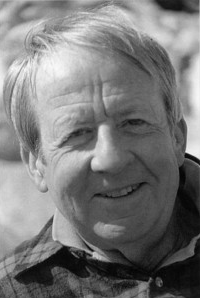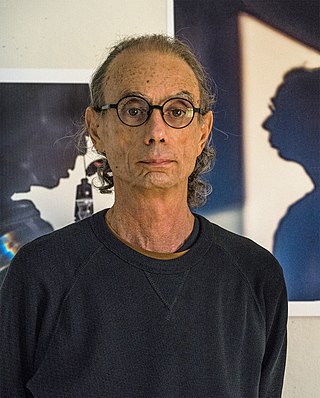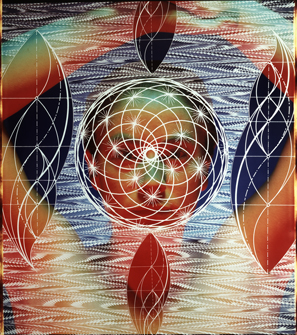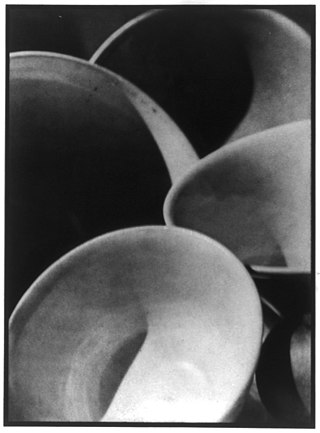
Paul Strand was an American photographer and filmmaker who, along with fellow modernist photographers like Alfred Stieglitz and Edward Weston, helped establish photography as an art form in the 20th century. In 1936, he helped found the Photo League, a cooperative of photographers who banded together around a range of common social and creative causes. His diverse body of work, spanning six decades, covers numerous genres and subjects throughout the Americas, Europe, and Africa.

Precisionism was a modernist art movement that emerged in the United States after World War I. Influenced by Cubism, Purism, and Futurism, Precisionist artists reduced subjects to their essential geometric shapes, eliminated detail, and often used planes of light to create a sense of crisp focus and suggest the sleekness and sheen of machine forms. At the height of its popularity during the 1920s and early 1930s, Precisionism celebrated the new American landscape of skyscrapers, bridges, and factories in a form that has also been called "Cubist-Realism." The term "Precisionism" was first coined in the mid-1920s, possibly by Museum of Modern Art director Alfred H. Barr although according to Amy Dempsey the term "Precisionism" was coined by Charles Sheeler. Painters working in this style were also known as the "Immaculates", which was the more commonly used term at the time. The stiffness of both art-historical labels suggests the difficulties contemporary critics had in attempting to characterize these artists.
Irving Penn was an American photographer known for his fashion photography, portraits, and still lifes. Penn's career included work at Vogue magazine, and independent advertising work for clients including Issey Miyake and Clinique. His work has been exhibited internationally and continues to inform the art of photography.

A photogram is a photographic image made without a camera by placing objects directly onto the surface of a light-sensitive material such as photographic paper and then exposing it to light.

Charles Sheeler was an American artist known for his Precisionist paintings, commercial photography, and the avant-garde film, Manhatta, which he made in collaboration with Paul Strand. Sheeler is recognized as one of the early adopters of modernism in American art.

John Marin was an early American modernist artist. He is known for his abstract landscapes and watercolors.

Robert Natkin was an American abstract painter whose work is associated with abstract expressionism, color field painting, and Lyrical Abstraction.
Friedel Dzubas was a German-born American abstract painter.
Ezra Stoller was an American architectural photographer.

Clifford Ross is an American artist who has worked in multiple forms of media, including sculpture, painting, photography and video. His work is in the collections of the Museum of Modern Art, the J. Paul Getty Museum, the Metropolitan Museum of Art, the Whitney Museum of American Art, the Museum of Fine Arts, Houston, and the Philadelphia Museum of Art.

Ray K. Metzker was an American photographer known chiefly for his bold, experimental B&W cityscapes and for his large "composites", assemblages of printed film strips and single frames. His work is held in various major public collections and is the subject of eight monographs. He received awards from the John Simon Guggenheim Memorial Foundation, National Endowment for the Arts and Royal Photographic Society.
James Welling is an American artist, photographer and educator living in New York City. He attended Carnegie-Mellon University where he studied drawing with Gandy Brodie and at the University of Pittsburgh where he took modern dance classes. Welling transferred to the California Institute of the Arts in Valencia, California in 1971 and received a B.F.A. and an M.F.A. in the School of Art. At Cal Arts, he studied with John Baldessari, Wolfgang Stoerchle and Jack Goldstein.

Stephen Greene was an American artist known for his abstract paintings and in the 1940s his social realist figure paintings.
Eileen Quinlan is a self-described still-life photographer who shoots with medium format and large format cameras. An art critic for Art in America likened her style to that of Moholy-Nagy and James Welling.
Barbara Crane was an American artist photographer born in Chicago, Illinois. Crane worked with a variety of materials including Polaroid, gelatin silver, and platinum prints among others. She was known for her experimental and innovative work that challenges the straight photograph by incorporating sequencing, layered negatives, and repeated frames. Naomi Rosenblum notes that Crane "pioneered the use of repetition to convey the mechanical character of much of contemporary life, even in its recreational aspects."

David Lebe is an American photographer. He is best known for his experimental images using techniques such as pinhole cameras, hand-painted photographs, photograms, and light drawings. Many of his photographs explore issues of gay identity, homoeroticism, and living with AIDS, linking his work to that of contemporaries such as Robert Mapplethorpe, Peter Hujar, and David Wojnarowicz. Though his style and approach set him apart from these contemporaries, "Lebe is now incontrovertibly part of the history of twentieth-century queer artists."

Ellen Carey is an American artist known for conceptual photography exploring non-traditional approaches involving process, exposure, and paper. Her work has ranged from painted and multiple-exposure, Polaroid 20 x 24, Neo-Geo self-portraits beginning in the late 1970s to cameraless, abstract photograms and minimal Polaroid images from the 1990s onward, which critics often compare to color-field painting. Carey's sixty one-person exhibitions have been presented at museums, such as the Amon Carter Museum of American Art, International Center of Photography (ICP) and Wadsworth Atheneum Museum of Art, alternative spaces such as Hallwalls and Real Art Ways, and many commercial galleries. Her work is in numerous museum collections, including those of the Metropolitan Museum of Art, Whitney Museum of American Art, Los Angeles County Museum of Art, Centre Pompidou, and Smithsonian American Art Museum. In 2019, she was named one of the Royal Photographic Society (London) "Hundred Heroines", recognizing leading women photographers worldwide. Los Angeles Times critic Leah Ollman describes her photography as "inventive, physically involving, process-oriented work" and her recent photograms as "performative sculptures enacted in the gestational space of the darkroom" whose pure hues, shadows and color shifts deliver "optical buzz and conceptual bang." New York Times critic William Zimmer wrote that her work "aspires to be nothing less than a reinvention, or at least a reconsideration, of the roots or the essence of photography." In addition to her art career, Carey has also been a longtime educator at the Hartford Art School and a writer and researcher on the history of photography.

The Family, Luzzara, Italy is a black and white photograph by Paul Strand, taken in 1953. It was made during a five monts staying in Luzzara, in the Po River Valley, north Italy, the birthplace of his friend, screenwriter Cesare Zavattini, which was documented in the book Un Paese (1955), illustrated with his photographs and Zavattini's text. Strand's group of photographs depicts the hardships and conditions of the rural Italy at the time, and is directly related to the neorealism esthetic, of which Zavattini was an exponent in cinema.

Bowls, also known as Abstraction, Bowls, is a black and white photograph taken by Paul Strand in 1916. The photograph has elements of cubism and abstractionism, and exemplifies his style at the time.

The White Fence, also known as The White Fence, Port Kent, New York, is a black and white photograph taken by American photographer Paul Strand, in 1916. The picture was published in the magazine Camera Work, in June 1917, whose editor was Alfred Stieglitz, where it was highly praised by him, specially for its "abstract qualities". It would be later published as part of Paul Strand: Portfolio Three (1976-1977).














